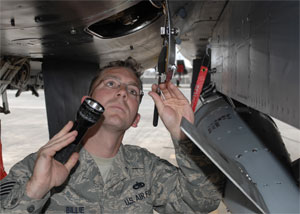

Maintenance/Repair
|
Alternative maintenance and return to service testing options are now available to most international owners and operators of Multifunctional Information Distribution System Low Volume Terminal (MIDS LVT). Previously, the only option for repair and return to service testing was to return the MIDS LVT to the DLS production and depot facility. |
|
Maintenance Concept
As the basis for the establishment of Intermediate Level (I-Level) Maintenance support, a three level maintenance concept will be implemented (Organizational to Intermediate to Depot). DLS will establish aftermarket support facilities in regional locations throughout the world. Each facility will have the capability to verify Line Replacable Unit (LRU) failures, troubleshoot to the failed Shop Replaceable Unit (SRU), remove and replace failed SRU, perform verification testing and return the repaired LRU to the customer. In this scenario, only the failed SRUs, not LRUs, would be returned to DLS in the United States for repair. The LRU will be repaired by replacing the failed SRUs with working SRUs from a spares inventory. This will greatly improve repair turn-around times, thus reducing the quantity of required spares.
Security Considerations
Organizational Levels
For Organizational Level (O-Level)
Maintenance, Terminal BIT will be used
at the flight line or forward area to
detect failures in the MIDS Terminals. A
Maintenance Test Set may be used by
maintainers to provide greater
visibility into verifying and
troubleshooting problems. The same test
set can be used to reprogram MIDS LVT
Terminals on the flight line as software
updates become available through the
U.S. Government.
A supply of MIDS LVT spare LRUs will be
required to allow rotation of failed
terminals in order to maintain the
customer-required level of availability.
The quantity of spares is dependent on
operating hours and availability
requirements. DLS can provide a
recommendation for the quantity required
based on those operating hours and
availability requirements.
Faulty LRUs will be removed at the
flight line or forward area and shipped
to the I-Level maintenance facility for
fault verification, SRU swap, and
return-to-service verification testing.
Intermediate Level
As noted earlier, the Intermediate Level (I-Level) maintenance support facilities will provide a regional repair center for the MIDS LVT. DLS customers will ship faulty MIDS LRUs to the support facility where they will be screened for faults. The facility will be used to:
• Identify No Fault Found (NFF) or Can Not Duplicate (CND) faults and prevent these LRUs from being sent back to the DLS Depot Level (D-Level) facility
• Identify faulty SRUs within the LRU and replace the faulty SRUs with functioning qualified spares
• Ship faulty SRUs to DLS for repair and receive repaired SRUs into stock.
To verify proper operation of the LRUs after NFF/CND or successful SRU swap, the LRU will go through a Repair Verification Test Procedure (RVTP), part number 987-9615-001. If the LRU passes the RVTP the unit will be returned to the flightline or forward area spares stock. Faulty SRUs will be shipped to the DLS D-Level repair facility for repair and acceptance testing and then returned to the I-Level maintenance facility spares stock. Serial Number tracking at the SRU and LRU level will be maintained at the facility as part of the logistics support contract.
A significant benefit of this capability is that primary sparing would be at the SRU level, that LRU repair would be completed on-site, and that the number of non-verified failures sent back to the DLS D-Level facility would be minimized. Spare SRUs will be maintained and managed at the Intermediate Maintenance facility at a level necessary to assure needed availability at the customer’s operational bases. Repair turn-around times would be reduced as LRUs would be repaired regionally and returned to the customer, eliminating lengthy transportation delays experienced during shipment to the DLS D-Level repair facility.
Depot Level
Depot Level (D-Level) repairs can only be
performed by the Original Equipment
Manufacturer’s (OEM’s) facilities. DLS has
OEM facilities that can be used for D-Level
repair located in Cedar Rapids, Iowa and
Wayne, New Jersey, USA.
D-Level facilities have the authorization
and capability of repair the components
within the SRUs down to the piece part
level. The repaired SRUs can then be tested
at the SRU level for proper functionality,
and, if necessary, tested at the LRU level
for further verification of functionality.
The SRUs that are identified as faulty at an
I-Level facility must be shipped to the DLS
D-Level facility for repair and testing.
Once the SRUs have been repaired and tested,
they will be shipped back to the I-Level
facility and returned to the customer’s
spares pool.
Terms of Access | Privacy Statement
